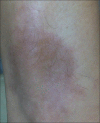Necrobiosis lipoidica: A clinicopathological study in the Indian scenario
- PMID: 24350007
- PMCID: PMC3853892
- DOI: 10.4103/2229-5178.120639
Necrobiosis lipoidica: A clinicopathological study in the Indian scenario
Abstract
Context: Necrobiosis lipoidica (NL) is a chronic granulomatous dermatitis that is commonly associated with diabetes mellitus. Most of the current knowledge about this entity is from western literature.
Aims: This study evaluates the clinicohistological features of NL in an Indian scenario.
Materials and methods: We retrospectively reviewed clinical features, associated comorbidities, and biopsies of all patients with NL over a period of one year.
Results: Five cases of NL were seen during the duration of the study. The preliminary clinical diagnosis ranged from sarcoidosis to tinea incognito. The commonest clinical presentation in the Indian scenario was of asymptomatic erythematous to skin-colored plaques and nodules on the shins with or without central atrophy. The most common site of involvement was the shin (3 of 5 patients). NL was associated with Diabetes mellitus in only two cases, both of whom were male patients. On histology, various patterns of inflammation were seen including the palisading, interstitial, and mixed granulomatous infiltrates. One patient had sarcoidal granulomas in association with an interstitial pattern. Features seen consistently in all cases include perivascular lymphoplasmacytic infiltrates, interstitial lymphocytic infiltrates, and fibroplasia. Interstitial mucin deposition was not observed in any of the biopsies.
Conclusion: The diagnosis of NL was missed in most cases due to the rarity of the disease, absence of concomitant diabetes, and atypical presentations. Histology was a useful tool in clinching the diagnosis.
Keywords: Diabetes; necrobiosis lipoidica; palisading granuloma.
Conflict of interest statement
Figures




Similar articles
-
Necrobiosis Lipoidica Diabeticorum: A pediatric case report.Dermatoendocrinol. 2014 Jan 1;6(1):e27790. doi: 10.4161/derm.27790. Epub 2014 Jan 17. Dermatoendocrinol. 2014. PMID: 24575162 Free PMC article.
-
Granuloma annulare and necrobiosis lipoidica tissue reactions as a manifestation of systemic disease.Hum Pathol. 1996 Jan;27(1):50-6. doi: 10.1016/s0046-8177(96)90137-9. Hum Pathol. 1996. PMID: 8543311
-
Necrobiosis lipoidica associated with sarcoidosis.J Cutan Pathol. 2018 Dec;45(12):944-948. doi: 10.1111/cup.13357. Epub 2018 Oct 9. J Cutan Pathol. 2018. PMID: 30216487
-
Cutaneous Granulomatosis: a Comprehensive Review.Clin Rev Allergy Immunol. 2018 Feb;54(1):131-146. doi: 10.1007/s12016-017-8666-8. Clin Rev Allergy Immunol. 2018. PMID: 29352388 Review.
-
Atypical presentation of necrobiosis lipoidica in a pediatric patient.Pediatr Dermatol. 2019 Jan;36(1):e31-e33. doi: 10.1111/pde.13716. Epub 2018 Dec 2. Pediatr Dermatol. 2019. PMID: 30506892 Review.
Cited by
-
Annular elastolytic giant cell granuloma: A report of 10 cases.Indian Dermatol Online J. 2015 Dec;6(Suppl 1):S17-20. doi: 10.4103/2229-5178.171055. Indian Dermatol Online J. 2015. PMID: 26904442 Free PMC article.
References
-
- Lowitt MH, Dover JS. Necrobiosis lipoidica. J Am Acad Dermatol. 1991;25:735. - PubMed
-
- Boulton AJ, Cutfield RG, Abouganem D, Angus E, Flynn HW, Jr, Skyler JS, et al. Necrobiosis lipoidica diabeticorum: A clinicopathologic study. J Am Acad Dermatol. 1988;18:530–7. - PubMed
-
- Joshi A, Rathi SK, Khanna N. Necrobiosis lipoidica mimicking cellulitis. Indian J Dermatol Venereol Leprol. 1997;63:191–2. - PubMed
-
- Mittal RR, Chopra AK, Walia R, Gill SS, Tapanjot Non-diabetic atypical necrobiosis lipoidica. Indian J Dermatol Venereol Leprol. 1994;60:345–6.
-
- Rollins TG, Winkelmann RK. Necrobiosis lipoidica granulomatosis: Necrobiosis lipoidica diabeticorum in the nondiabetic. Arch Dermatol. 1960;82:537–43. - PubMed
LinkOut - more resources
Full Text Sources
Other Literature Sources

